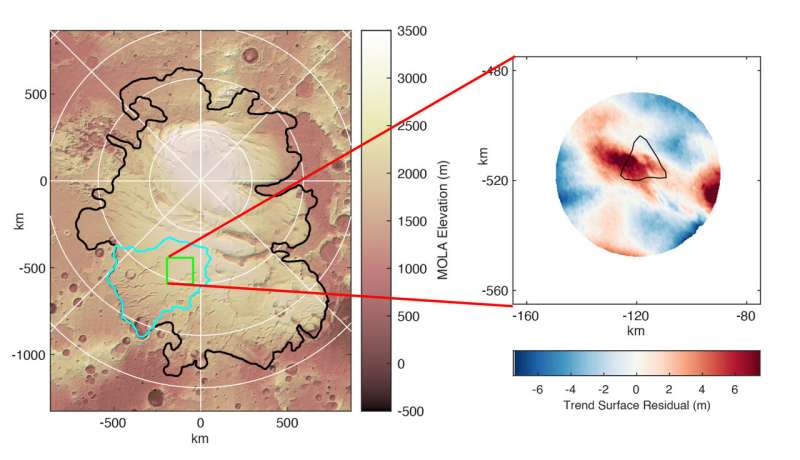
There is new evidence for the existence of water underneath the south polar ice cap of Mars.
The shape of the upper surface of the ice cap was measured by the University of Cambridge. Computer model predictions for how a body of water beneath the ice cap would affect the surface were shown.
They agree with the earlier ice-penetrating radar measurement that showed a potential area of liquid water beneath the ice. There is debate over whether the radar signal is due to liquid water or not.
The first independent line of evidence that there is liquid water beneath the south polar ice cap is provided by the results.
The combination of the new topographic evidence, our computer model results, and the radar data make it more likely that at least one area of subglacial liquid water exists on Mars today.
Mars has the same amount of water ice at the poles as the Greenland Ice Sheet. Unlike Earth's sheets ice, which are underlain by water filled channels and even large subglacial lakes, the polar ice caps on Mars have been thought to be frozen solid all the way to their beds.
Evidence from the European Space Agency's Mars Express satellite challenged the idea that this was true. Mars' southern ice cap can be seen through the MARSIS radar. The area at the base of the ice that reflected the radar signal was thought to be an area of liquid water beneath the ice cap.
If other types of dry materials exist beneath the ice cap, they could produce the same pattern of reflectance. Given the cold climate conditions, liquid water beneath the ice cap would require an additional heat source, such as geothermal heat from within the planet. Confirmation of the existence of this lake was left waiting.
The shape of the ice sheet is affected by subglacial lakes. Ice flow under gravity can be affected by the water in subglacial lakes. This leads to a depression in the ice surface above the lake and a raised area further down-flow.
The team, which included researchers from the University ofSheffield, the University of Nantes, University College, Dublin, and the Open University, used a range of techniques to examine data from NASA's Mars Global Surveyor satellite.
The depression and raised area of the surface undulation deviated from the surrounding ice surface. Similar to undulations over subglacial lakes here on Earth.
Liquid water at the bed could explain the observed undulation on the ice's surface. Simulations of ice flow were run on the computer. The patch of reduced bedfriction was put in the ice sheet bed to allow the ice to slide and speed up. The amount of heat coming from the planet was different. The simulations generated undulations that were the same size and shape as the real ice cap surface.
The similarity between the model-produced topographic undulation and the actual observations suggest that there is an accumulate of liquid water beneath the south polar ice cap.
"The quality of data coming back from Mars, from satellites as well as from the landers, is such that we can use it to answer really difficult questions about conditions on and under the planet's surface, using the same techniques we also use on Earth." It's great to use these techniques to find out about other planets.
More information: Neil Arnold, Surface topographic impact of subglacial water beneath the south polar ice cap of Mars, Nature Astronomy (2022). DOI: 10.1038/s41550-022-01782-0. www.nature.com/articles/s41550-022-01782-0 Journal information: Nature Astronomy